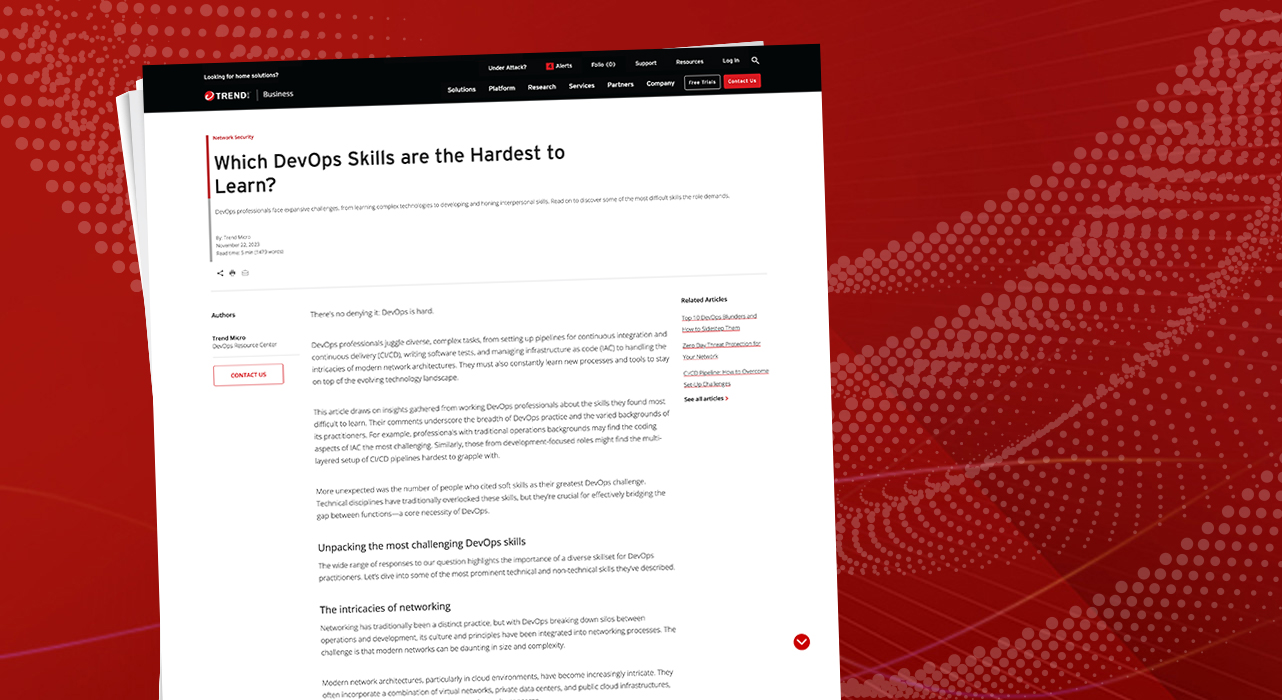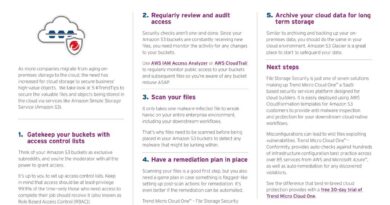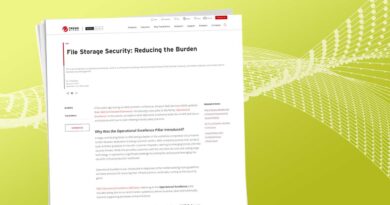Which DevOps Skills are the Hardest to Learn?


There’s no denying it: DevOps is hard.
DevOps professionals juggle diverse, complex tasks, from setting up pipelines for continuous integration and continuous delivery (CI/CD), writing software tests, and managing infrastructure as code (IAC) to handling the intricacies of modern network architectures. They must also constantly learn new processes and tools to stay on top of the evolving technology landscape.
This article draws on insights gathered from working DevOps professionals about the skills they found most difficult to learn. Their comments underscore the breadth of DevOps practice and the varied backgrounds of its practitioners. For example, professionals with traditional operations backgrounds may find the coding aspects of IAC the most challenging. Similarly, those from development-focused roles might find the multi-layered setup of CI/CD pipelines hardest to grapple with.
More unexpected was the number of people who cited soft skills as their greatest DevOps challenge. Technical disciplines have traditionally overlooked these skills, but they’re crucial for effectively bridging the gap between functions—a core necessity of DevOps.
Unpacking the most challenging DevOps skills
The wide range of responses to our question highlights the importance of a diverse skillset for DevOps practitioners. Let’s dive into some of the most prominent technical and non-technical skills they’ve described.
The intricacies of networking
Networking has traditionally been a distinct practice, but with DevOps breaking down silos between operations and development, its culture and principles have been integrated into networking processes. The challenge is that modern networks can be daunting in size and complexity.
Modern network architectures, particularly in cloud environments, have become increasingly intricate. They often incorporate a combination of virtual networks, private data centers, and public cloud infrastructures, each with distinct protocols, configurations, and security concerns.
As enterprises move to distributed systems to ensure scalability and resilience, maintaining secure and efficient communication among these systems becomes even more challenging. Subtle misconfigurations or missing security patches can lead to significant vulnerabilities or performance bottlenecks.
At the same time, there’s been a shift from traditional, hardware-based networking to software-defined networking (SDN). SDN allows for dynamically programmable and adaptable network configurations powered by automation—so it’s a boon to scalability and agility. However, it also means that networking is no longer just about physical connections but also about code and software, further intertwining DevOps and networking.
This shift requires DevOps practitioners to understand networking principles more deeply, ensuring that applications function effectively and communicate efficiently and securely within the broader network ecosystem.
The craft of writing software tests
Writing software tests is equal parts art and science. Writing sound tests requires a thorough understanding of the system you’re testing and the ability to foresee and simulate potential failures. And as the DevOps approach embeds testing throughout the development lifecycle, the task may become challenging.
When testing, it’s crucial to strike the right balance between different types of tests to maintain the rapid development lifecycle that DevOps aims to achieve:
- Unit tests focus on individual components, ensuring each function or method operates in isolation.
- Integration tests examine how these units collaborate, uncovering discrepancies in their interactions.
- End-to-end tests validate the system flow, from user input to expected output, ensuring the software works cohesively.
Putting too much emphasis on one test or overlooking another can have serious ramifications. For example, while end-to-end tests cover a release’s entire functionality in one go, they’re also slower and costlier than other tests. Too many end-to-end tests and too few unit and integration tests will result in longer feedback loops and a slower production process.
However, to dispense with end-to-end testing in favor of unit testing would also be a bad idea—it’s not uncommon for applications to pass a complete suite of unit tests and fail end-to-end testing due to an unforeseen error. The right balance of tests ensures that you’re not compromising on speed or stability.
Finally, the DevOps approach requires integrating testing within CI/CD pipelines—a critical factor in enabling automated, efficient, and error-free software delivery. Executing testing, including legacy tests, within the pipeline gives you confidence that there will be no regression in functionality. Once tests are fully incorporated, you receive instant feedback when committing changes so you can quickly rectify issues and prevent functional deterioration. Embedded testing ensures consistent software quality and accelerates the production process.
What’s more, placing testing at the heart of CI/CD also requires developers, testers, and operations to work together closely, furthering the DevOps ethos of cross-functional collaboration.
Mastery of infrastructure as code
IAC transforms traditional infrastructure management paradigms, enabling you to provision and manage IT infrastructures using code and software development techniques.
For many DevOps professionals, transitioning from hands-on, manual configurations to scripted, automated deployments has a steep learning curve. This convergence of infrastructure and code requires a deep understanding of the system so that practitioners can make informed upfront decisions about its development and operation.
IAC offers essential benefits to DevOps, like consistent deployments, scalability, and rapid provisioning. Another advantage is that IAC makes infrastructure part of the standard code review process, just like the application code.
A key issue that IAC aims to alleviate is configuration drift. If operations teams make improperly tested changes to the environment, discrepancies can arise between the environment’s runtime configuration and its documented state. When infrastructure is part of a project’s codebase (as with IAC), you can avoid drift by applying DevOps best practices—like stringent change control and automated monitoring.However, if teams don’t properly implement these practices, the rapid changes and increased complexity of DevOps may increase the risk of configuration drift.
For all these reasons, IAC can be challenging to implement. Managing complex infrastructure scripts is cumbersome, and misconfigurations can lead to security vulnerabilities. Organizations must have the discipline, processes, and monitoring in place to reap the benefits and mitigate the risks of IAC.
The intricacies of containerization and orchestration
Containerization has revolutionized the DevOps landscape. By packaging, distributing, and managing applications within containers, you can ensure applications run consistently across multiple environments. But containerization also increases complexity, especially when orchestrating at scale.
Tools like Docker have made creating and managing individual containers relatively straightforward. But when you move from a handful of containers to hundreds or thousands, effective orchestration becomes a necessity, which is where solutions like Kubernetes come in.
Kubernetes is an orchestration platform that automates containerized applications’ deployment, scaling, and management. It’s exceptionally potent, with myriad configurations and services, meaning it also poses a steep learning curve for DevOps professionals.
Security is another issue with containers. Ensuring security within these environments is imperative, particularly when applications communicate across containers or when containers access external resources. Furthermore, as businesses grow, their infrastructure needs to keep up.
Ensuring infrastructure scalability while maintaining resilience in the face of potential failures is a priority. The complex web of configurations, services, and interdependencies compounds these challenges, increasing the depth and breadth of knowledge that DevOps professionals must develop.
The unexpected challenge of soft skills
With the traditional siloed approach, the development and operations teams work with fixed, stable roles and even unique terminology that outsiders may struggle to keep up with. The DevOps approach breaks down these departmental silos—teams change rapidly, with roles and responsibilities fluctuating over time. Here, cross-functional working is the norm.
But this approach also raises an issue that tends to receive little attention. To successfully navigate this shifting landscape, everyone must speak a common language and share similar practices. DevOps practitioners must communicate with people with different skillsets and experiences, show empathy, and be adaptable. In other words, they need to develop their soft skills.
Soft skills encompass personal and interpersonal abilities that facilitate effective interaction and collaboration, for example:
- Communication: Success in DevOps depends on seamless collaboration between development and operations teams. Strong communication skills are, therefore, essential to understanding and integrating diverse perspectives.
- Empathy: Empathy is another vital competency, letting you grasp your colleagues’ challenges and understand the pressures on every team. An empathetic approach also helps foster a healthy, no-blame culture.
- Adaptability: Being adaptable is crucial, as DevOps is perpetually evolving and introducing a constant stream of new technologies to integrate.
The above skills are invaluable across day-to-day DevOps practices. You may often encounter scenarios where you must explain intricate technical issues to non-technical stakeholders. Without effective communication and empathy, conversations like this can become exercises in frustration.
Similarly, grasping user needs isn’t just about analyzing and interpreting data—it’s about putting yourself in the users’ shoes and genuinely understanding their experience. And when tensions inevitably arise between development and operations, both sides can find common ground by exercising their soft skills.
While you can gain technical competencies in DevOps through structured training and practice, soft skills demand personal growth and introspection. Excelling at these skills requires individuals to look inward, evaluate their interactions, and work intentionally to better understand and connect with others.
Read More HERE



